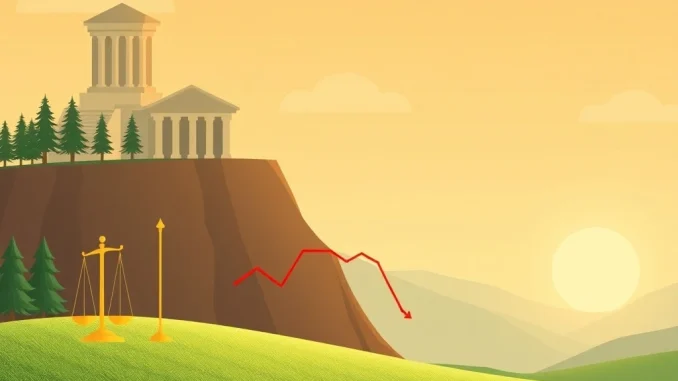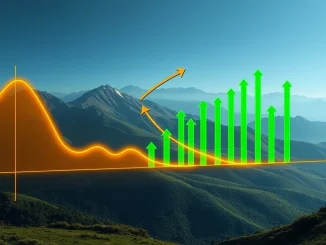
For anyone navigating the dynamic world of cryptocurrencies, understanding broader financial market signals is crucial. The recent, remarkable VIX drop to a five-month low is one such signal that resonates far beyond traditional equities, hinting at a calmer macroeconomic sea that often benefits digital assets. This significant decline in the Chicago Board Options Exchange (CBOE) Volatility Index, often dubbed the market’s ‘fear gauge,’ suggests a substantial shift in investor sentiment and a potential era of reduced market volatility.
What Does the VIX Drop Mean for Investor Confidence?
On July 24, 2025, the VIX, a key measure of 30-day equity market expectations, declined 0.86 points to 15.64, marking its lowest point in five months. This movement isn’t just a number; it reflects a broader trend of diminished investor anxiety. When the VIX falls, it typically indicates that market participants perceive less risk in the near term, leading to increased investor confidence. This shift is driven by a combination of factors, including more predictable economic indicators and a clearer path for central bank actions.
Here’s why this matters:
- Reduced Hedging Activity: A lower VIX suggests investors are less inclined to purchase expensive put options to protect against sharp market downturns. This reduced demand for ‘insurance’ reflects a belief that significant negative shocks are less likely.
- Shift to Risk-On Assets: With less fear, capital tends to flow from safe-haven assets into more growth-oriented investments, including equities and, by extension, potentially cryptocurrencies, which are often considered higher-beta assets.
- Improved Market Visibility: Clarity on economic conditions and monetary policy helps investors make more informed decisions, reducing the need for panic-driven reactions.
Stable Inflation: A Key Driver of Market Calm?
One of the primary catalysts behind the VIX’s retreat is the ongoing trend of stable inflation in major economies. For a long time, persistent inflation was a significant source of market uncertainty, forcing central banks to adopt aggressive monetary tightening policies. Now, with inflation showing signs of cooling and stabilizing, the pressure on central banks to hike rates aggressively has lessened. This creates a more predictable economic environment, reducing one of the major sources of market jitters.
The interplay is clear:
| Economic Factor | Impact on Inflation | Impact on VIX/Market |
|---|---|---|
| Cooling Demand | Helps stabilize prices | Reduces volatility, boosts confidence |
| Supply Chain Normalization | Eases cost pressures | Supports predictable pricing, calms markets |
| Measured Monetary Policy | Anchors inflation expectations | Provides stability, lowers VIX |
This period of stable inflation allows businesses and consumers to plan with greater certainty, which translates into a more confident investment landscape.
How Does Fed Policy Influence Market Volatility?
The Federal Reserve’s measured approach to monetary policy normalization has been instrumental in taming market volatility. After a period of aggressive rate hikes, the Fed has signaled a more cautious stance, emphasizing data dependency and a willingness to adjust course as needed. This nuanced approach avoids sudden shocks to the financial system, providing markets with a sense of stability.
Consider these points regarding Fed policy:
- Clear Communication: The Fed’s efforts to clearly communicate its intentions and outlook reduce speculation and uncertainty, which are major drivers of volatility.
- Gradual Adjustments: Rather than abrupt shifts, a gradual approach to interest rate adjustments and balance sheet reduction allows markets to absorb changes without significant disruption.
- Confidence in Central Bank Support: Investors perceive that central banks are attentive to market conditions and willing to act to prevent severe economic downturns, fostering a sense of security.
This predictable Fed policy environment significantly contributes to the current low VIX levels, making it easier for investors to forecast future economic conditions.
Implications for Equity Markets and Beyond
The VIX drop has tangible implications across financial markets. Lower volatility typically reduces the demand for defensive assets, such as out-of-the-money put options, which are used as insurance against market declines. This has led to a contraction in defensive asset trading volumes, while speculative positions in equities have gained traction.
For instance, while CME Group’s Q2 2025 earnings report highlighted record quarterly revenue fueled by increased trading activity, this growth was attributed to broader market dynamics rather than the VIX’s specific trajectory. The interplay between the VIX’s decline and elevated trading volumes underscores the nuanced dynamics of risk perception in the current financial environment.
From an institutional perspective, the VIX’s five-month low has prompted a reassessment of portfolio allocations. Portfolio managers are increasingly favoring large-cap technology stocks and cyclical sectors, which have outperformed defensive holdings in recent weeks. This shift reflects confidence in corporate earnings and central bank support, creating a favorable backdrop for growth-oriented investments, including the digital asset space.
Lingering Uncertainties and the Path Ahead
While the current market calm is a welcome development, analysts caution that the VIX’s decline should not be interpreted as a permanent structural change. The financial landscape remains susceptible to external shocks. Ongoing geopolitical tensions, such as regional conflicts or trade disputes, could rapidly reignite market fear. Similarly, unresolved supply-chain bottlenecks, though improving, still pose a risk of renewed inflationary pressures or economic disruptions.
The VIX’s trajectory also raises questions about the viability of volatility-linked investment products. Exchange-traded funds (ETFs) designed to track the VIX have seen reduced inflows as investors reallocate capital to core equity exposures. This trend puts downward pressure on volatility-focused strategies, which previously thrived during periods of market stress.
Market participants are now closely monitoring the VIX for signs of reversal. Technical indicators suggest the index is near critical support levels. A sustained break below these thresholds could trigger further downward momentum, indicating deeper market calm. Conversely, unexpected macroeconomic shocks—such as a sharp rise in inflation or a policy misstep by central banks—could rapidly reverse the current trend, pushing the VIX higher.
Conclusion: Cautious Optimism in a Shifting Landscape
The remarkable VIX drop to a five-month low reinforces a narrative of cautious optimism. It reflects a market that is balancing robust growth expectations against lingering uncertainties. For cryptocurrency investors, this broader market stability often translates into a more favorable environment, as reduced systemic risk can encourage capital flows into higher-risk, higher-reward assets. While the current calm is a positive sign, staying informed about global economic shifts and central bank communications remains paramount. The financial world is dynamic, and vigilance is key to navigating its ever-evolving currents.
Frequently Asked Questions (FAQs)
Q1: What is the VIX and why is its drop significant?
The VIX, or CBOE Volatility Index, is a real-time market index representing the market’s expectation of 30-day forward-looking volatility. It’s often called the ‘fear gauge.’ Its drop is significant because it indicates reduced investor anxiety and lower expectations for large, rapid market movements, signaling increased market stability and investor confidence.
Q2: How does stable inflation contribute to a lower VIX?
Stable inflation reduces uncertainty about future interest rate policies and corporate earnings. When inflation is predictable and under control, central banks are less likely to implement aggressive monetary tightening, which often causes market turbulence. This predictability fosters a calmer market environment, leading to a lower VIX.
Q3: What role does Fed policy play in market volatility?
The Federal Reserve’s monetary policy, especially its approach to interest rates and quantitative easing/tightening, profoundly influences market volatility. A clear, measured, and predictable Fed policy reduces uncertainty among investors. When the Fed communicates effectively and avoids sudden policy shifts, it helps to anchor market expectations and reduce sharp swings, thus contributing to a lower VIX.
Q4: Does a low VIX mean there are no risks in the market?
No, a low VIX does not mean the market is risk-free. While it indicates lower *expected* volatility in the near term and higher investor confidence, potential catalysts for renewed volatility remain. These can include unexpected geopolitical events, new inflationary pressures, or unforeseen economic shocks. A low VIX suggests complacency can be dangerous if underlying risks are ignored.
Q5: How does the VIX drop impact derivative markets?
A VIX drop typically reduces the demand for volatility-linked derivatives, particularly out-of-the-money put options used for hedging against market downturns. This can lead to decreased trading volumes in defensive derivatives and an increase in speculative positions in equities and other risk-on assets, as investors feel less need for insurance against market swings.



